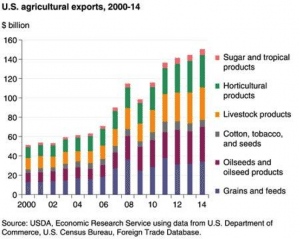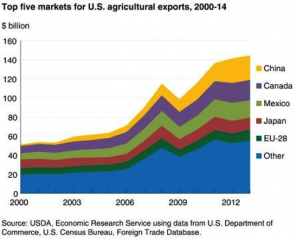With many big questions and trade disputes left to be resolved, the Trans-Pacific Partnership (TPP) is expected to be unusually complex, perhaps at an unprecedented level. The TPP is sufficiently complex that it’s perhaps best to start the discussion with some graphics showing the twelve countries involved, and their existing FTAs, as well as a chart of all 30 negotiating topics which may form chapters of the final agreement: 

It’s clear that the TPP is unusually complex as international agreements go. It could be that since the Doha round has been deadlocked, it’s worth pursuing similar issues with a smaller set of countries. By contrast, each GATT round generally discussed tariff reductions and trade for one or two industries over time. Arms negotiations were rarely comprehensive. Nuclear and conventional weapons treaties were usually negotiated separately, and particular issues like weapons in space, or ABMs were also negotiated in separate treaties. The only real value in having so much on the table is that it allows a lot of opportunities for trade offs that could lead to an agreement. For instance, Japan could consent to greater access for American cars and automotive parts if the U.S. concedes a bit on access in some of the five “sacred” food categories that are currently heavily protected from imports. While complexity affords creative bargaining, it has also led to an unusual level of privacy. With so many entrenched domestic constituencies potentially affected, it would be difficult to conduct public and open negotiations. Privacy allows negotiators to explore tentative agreements without exposing them to the rigors of public opinion. President Obama, like prior presidents, sought Trade Promotional Authority from Congress for just this reason. It allows the executive branch to bargain without oversight. However, Congress retains the right to reject the entire treaty when negotiations end. Knowing this, any wise president will keep domestic political interests in mind. Debating in the here and now One negative aspect of the low visibility of the negotiations is that potential supporters and opponents alike have had relatively little public information to draw from. The political debate in Congress about granting TPA was often shrill but also drew primarily from broad general cases. Opponents, including organized labor, made frequent reference to industrial job loss the U.S. experienced with NAFTA and other trade agreements. Supporters often drew on classical economics and the value of free trade as an eventual win-win for parties to FTAs. Critics also discussed very real U.S. losses to both Japan and China, since both countries gave lip service to free trade while really pursuing mercantilist policies. Factors Beyond Trade Paul Krugman had unique insight during the NAFTA debate that the impetus behind the treaty was more about strategic than trade issues. He saw the value of integrating the Mexican economy into the existing U.S.-Canada free trade zone was to strengthen the hand of pro U.S. Mexican reformers who had come to power. Likewise, in this case, the president himself defended the TPP, insisting that the U.S. sets trade rules and continues to have access to Asia despite China’s efforts to integrate Asia in its image. This is no small matter, since the TPP area reflects 40% of total global trade. The statement is also realistic rather than provocative. While many still believe the U.S. China relationship can be productive, it’s still true that China has initiated the AIIB, the new Silk Road aid program, and joined and hosted the Regional Comprehensive Economic Partnership. The last of these is seen by some to be in response to the TPP. Speicifc areas of US interest: Agriculture Fertile soil, a temperate climate, efficient farming, and good distribution have made U.S. agricultural exports relatively low cost and attractive. U.S. agricultural exports have proven robust and continue to grow. There are even substantial exports to Asia. 

However, agricultural free trade has proven politically difficult internationally. While the European CAP now has opened a bit to developing areas, it took a long time to do so. Negotiations with Japan could be predictive. When Japan joined the TPP negotiations in 2013, Prime Minister Abe announced plans to abolish tariffs on some of Japan’s “sacred five” product segments: rice, wheat, beef and pork, dairy products and sugar. This meant a review of 586 items classified within these five areas. He and the chair of the LDP’s TPP committee immediately had to backtrack because of internal LDP dissent and party ties to farming interests. Abe pledged that only certain tariff lines would be eliminated. Under U.S. protest Japan’s position is rumored to return to providing more access. Canada is also at issue, since it maintains import protections on poultry, eggs, and dairy. Significant imports would upset existing subsidies provided to these producers as part of a supply management regime. U.S. sugar producers want to continue U.S. protectionism for domestically produced sugar, but U.S. confectionary producers want these dropped since foreign imports would lower their production costs. Speicifc areas of US interest: Pharmaceuticals Big pharma in the U.S. is big business. In trade terms it could be looked upon as being subsidized since the U.S. Institutes of Health and Mental Health contribute substantial funding to their research costs. Their patents are guaranteed in the U.S. for 20 years but this is often before the drug is developed or FDA approved. Some patents run out before the drug reaches the market. In that case, exclusivity is granted for 5 years. At the end of this period the drug can be produced by generic drug firms. The U.S.-Peru FTA follows the U.S. practice of 5 years, but proposals from Canada, Chile, Malaysia and New Zealand have dropped this protection. The U.S. is negotiating bilaterally with each. U.S. generic drug manufacturers are aligned with other interests favoring shorter exclusivity terms. There’s also a proposal for permitting developing countries more liberal access to new drugs. Additional issues yet to develop - How the negotiators decide to change the status of State Owned Industries and favored firms to prevent unfair trade practices against private firms
- The development of a multilateral agreements to handle environmental disputes
- If the negotiators adhere to the dispute mechanism drawn from other US FTAs that begin with disputant consultation but can escalate to a more formal but neutral dispute panel.
- The handling of non-tariff barriers like misused health and safety regulations
- The development of the financial services agreement
- Whether China would be admitted if it agreed to the basic principles of the organization | 